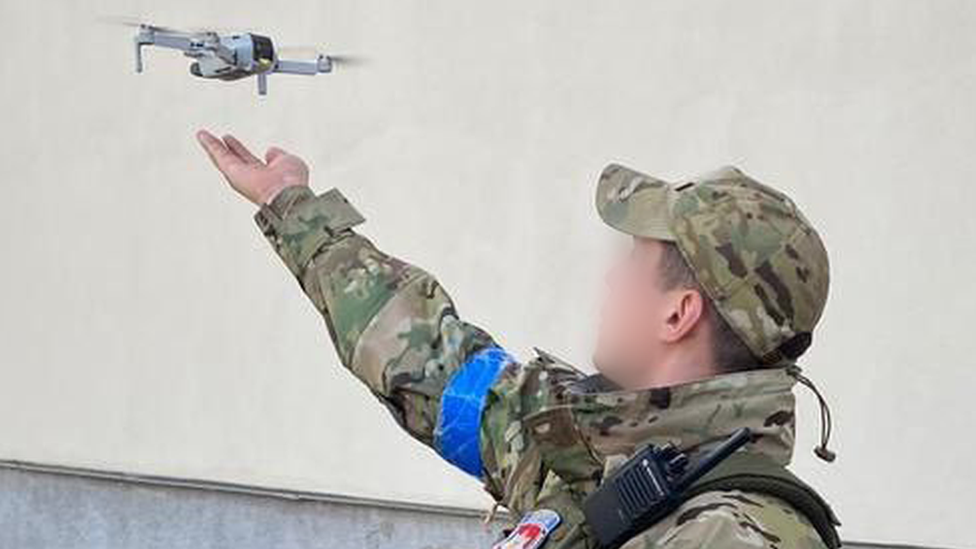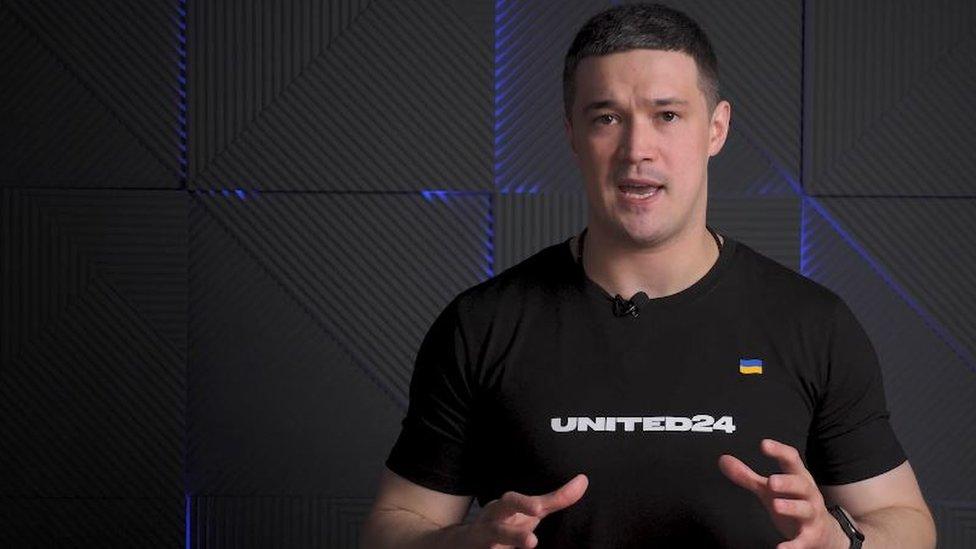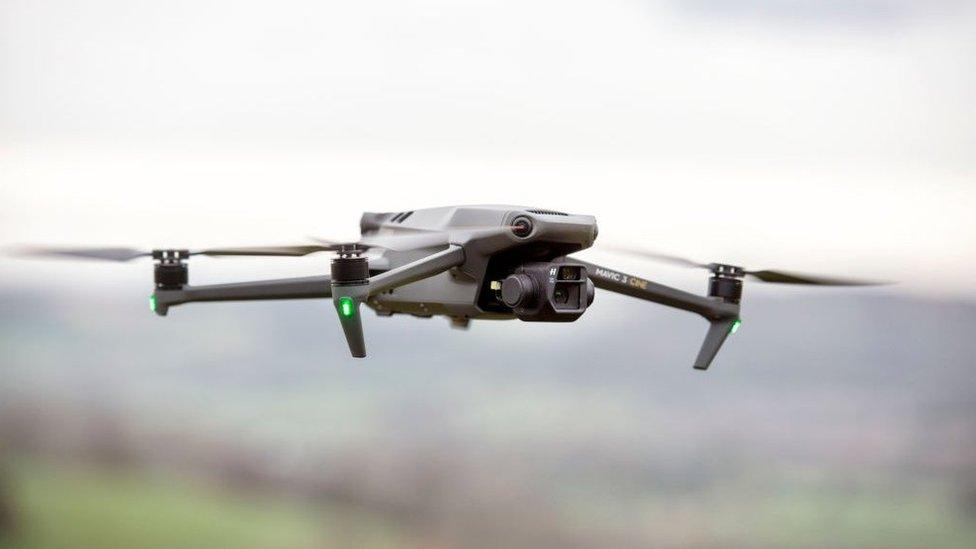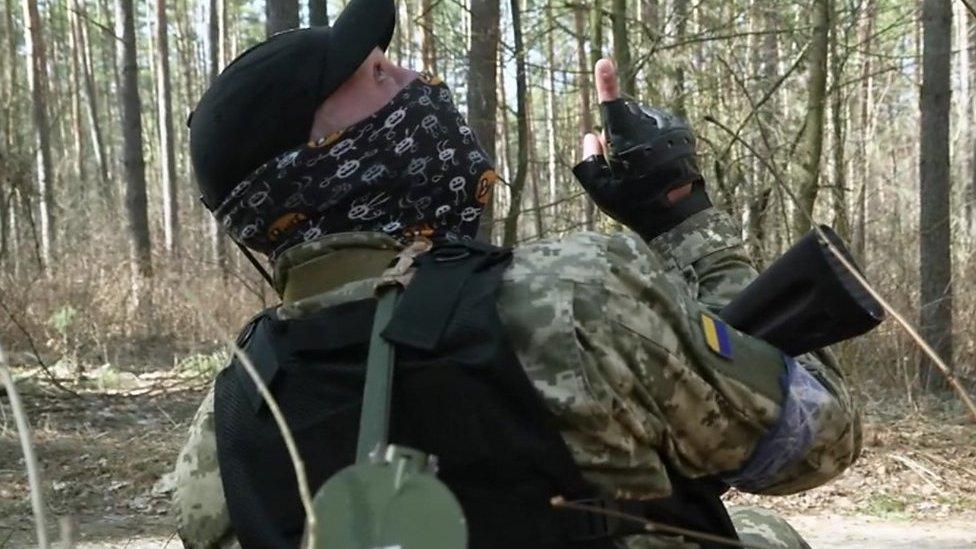Ukraine sent dozens of 'dronations' to build army of drones
- Published

A Ukrainian soldier uses a small consumer drone
Dozens of people have given their hobby and commercial drones to Ukraine after it appealed for "dronations" to help build its "army of drones".
The country is also asking for money to buy 200 military reconnaissance drones.
Ukrainian and Russian forces have used small consumer drones, or unmanned aerial vehicles (UAV), in the war.
But Justin Bronk, of the Royal United Services Institute (RUSI), says while small drones are useful, tactics are adapting to counter them.
Small and commercial drones can provide a live view of the enemy's positions, he says.
"Both sides in Ukraine have been able to very rapidly exploit that real-time video picture, to call down artillery fire and quickly correct it so that it's very, very accurate, even when using old school unguided artillery, on to enemy forces," he said.
But he warned electronic counter-measures were becoming increasingly effective.
Drone force
The proposed army of drones is a complex programme involving procurement, maintenance and replacement, as well as pilot training, Ukraine says.
Col Oleksii Noskov, assistant commander-in-chief of Ukraine's armed forces, said: "The army of drones will allow us to constantly monitor the 2,470km-long (1,535 miles) front line and to field an effective response to enemy attacks, using modern technology."
Mykhailo Fedorov, Ukraine's minister of digital transformation, told the BBC via email that the first goal of the campaign was to purchase tactical drones which have a 100-mile range and are equipped with a sophisticated camera, GPS and mapping tools.
However, after studying the issue, he said "our team understood that Ukraine's army still needed quadcopters", and so he said the country was asking people to "donate their own drones".
Ukraine hopes to collect thousands of multi-use and commercial UAVs.
Drones which meet the minimum standards are being donated to Ukraine via two warehouses, one in Poland and the other in the US.
Mr Fedorov also wants companies to get involved, adding: "This project is a great opportunity for drone manufacturers to test their equipment in harsh conditions."
The campaign, which was launched on Friday, has already raised £5.7m, enabling the purchase of two military UAVs. Dozens of small drones had also been received, Mr Fedorov tweeted., external
The military "warmate" drones, according to Mr Bronk, are a type of loitering munition manufactured in Poland. According to the company's website, the drone "constitutes a good alternative for anti-tank guided missiles".
No buy zone
According to Mr Fedorov, hobby and commercial drones have already shown their effectiveness on the battlefield.
Russia has also made use of them.
Earlier this year, Mr Fedorov called on market leader DJI to stop selling drones in Russia and, in a significant intervention for a Chinese firm, it halted sales in both Russia and Ukraine.
"Russia is using hobby/commercial drones to strike and conduct reconnaissance in their unprovoked and unfair war," Mr Fedorov wrote.
"It is crucial that the world's largest commercial drone-maker, DJI, stopped sales in Russia."

Mykhailo Fedorov appeals for "dronations"
Valerii Iakovenko, co-founder of Ukrainian company DroneUA, told BBC News that DJI's action had pushed up costs to Ukraine, while Russia was still able to continue to obtain drones via Belarus.
His company had been supplying drones and robotics to the government since before the war.
Drones, along with Elon Musk's Starlink satellite internet system and professional radio equipment, were now among the most sought-after technology, he said.
And even small ones were useful mostly providing field data, locating enemy troops and correcting artillery fire.
"A huge number of volunteer operators that joined the Ukrainian forces are also making a difference," Mr Iakovenko said.
"Drone pilots of small consumer drones are providing aerial intelligence along the whole front line.
"It is all about the speed of information exchange between the field and in the general staff, to make decisions almost immediately."
Watch: The volunteers using drones to monitor Russian troops
Raising morale
Mr Bronk says Ukrainians in particular have been very inventive in finding ways to source and then use commercial, as well as military-grade drones.
This includes "using them as improvised loitering munitions to strike targets at significant distance, including, recently, an oil refinery in Rostov with a commercial grade UAV with an improvised warhead".
But tactics, he warns, are changing.
"What's happened in the last couple of months in Donbas is that the Russians have managed to concentrate their electronic warfare assets and integrate them well with their ongoing operations.
As a result, Mr Bronk says, whenever Ukraine sends up a small UAV using radio remote control "the Russian electronic warfare kit picks it up and immediately either takes it over or just cuts the command link electronically and forces it to return".
To avoid this, instead of being flown by remote control, small drones have to be programmed to fly a set route and have targets identified when footage is analysed on their return. This slow process is of limited value against moving targets, he said.
Mr Bronk felt that what Ukraine needed were loitering munitions capable of targeting and attacking Russian electronic warfare systems.
While hobbyist drones were useful, at the moment "grassroots support in terms of generating military equipment is probably of as much value in terms of morale for the people who are contributing, as well as the people on the front lines".
Related topics
- Published27 April 2022

- Published27 March 2022
